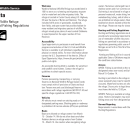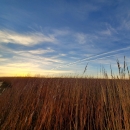Visit Us
National wildlife refuges offer us all a chance to unplug from the stresses of daily life and reconnect with our natural surroundings. Optima National Wildlife Refuge offers wildlife-dependent recreation, including opportunities to watch and photograph wildlife and public hunting.
Driving Directions
Located two miles north of Hardesty and approximately 19 miles east of Guymon, on State Highway 3/Highway 412 in Texas County, Oklahoma.
Fees
There is no charge to visit.
Restrooms
There are no facilities at the refuge.
Points of Interest
The bottomland habitat contains mature cottonwoods and tallgrass prairie species such as big and little bluestem, and indiangrass. This area offers a home to many species of native wildlife, and provides for a variety of wildlife-dependent recreational opportunities.
The refuge provides an island of prime habitat for resident species such as white-tailed deer, coyotes, Rio Grande turkeys, quail, and many others. Because of its important habitats, Optima National Wildlife Refuge is a migratory stopover and summer home to many species of songbirds and raptors.
Raptors are common year-round. During the spring and summer months, common species include the Swainson's hawk, Mississippi kite, American kestrel, red-tailed hawk, northern harrier, and turkey vulture. Species common in the fall and winter months are bald and golden eagles, prairie falcon, rough-legged hawk, Cooper's hawk, and ferruginous hawk. Resident game birds include the Rio Grande wild turkey, ring-necked pheasant, bobwhite quail, and scaled quail.
A variety of mammals are also found on the refuge, including mule deer, bobcat, porcupine, black-tailed jackrabbit, badger, raccoon, and striped skunk. Reptiles include the prairie rattlesnake and the Texas horned lizard, commonly called the horned toad.
What To Do
White-tailed deer, turkey, quail, pheasant, dove and rabbit hunting are the main visitor activities at Optima National Wildlife Refuge. All hunting is restricted to shotgun or archery and walk-in access only. Special hunting regulations can be found in the public lands portion of the Oklahoma Hunting Guide.
Know Before You Go
The refuge is walk-in access only and there are no facilities at the refuge.
Visitor Tips
- Dawn and dusk are the best times to see wildlife.
- In warmer seasons, few animals are moving on hot summer afternoons or on windy days.
- Observe from the sidelines. Leave “abandoned” young animals alone. A parent is probably close by waiting for you to leave.
- Don’t offer snacks to wildlife; your lunch could disrupt wild digestive systems.
- Try sitting quietly in one good location. Let wildlife get used to your presence. Many animals that have hidden will reappear once they think you are gone.
- Walk quietly and be aware of sounds and smells. Often you will hear more than you will see.
- Teach children quiet observation. Other wildlife watchers will appreciate your consideration.
- Look for animal signs. Tracks, scat, feathers, and nests left behind often tell interesting stories.
Activities
Hunting, birding, and photography are some of the many ways to enjoy the refuge.
Related Documents
Optima NWR Hunting Regulations
Other Facilities in the Complex
Optima National Wildlife Refuge is unstaffed and managed through Washita National Wildlife Refuge office.



